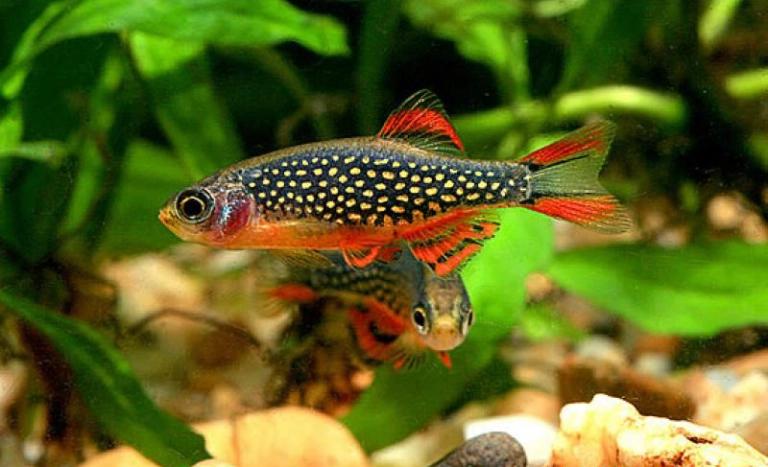
Size
Celestial Pearl Danios typically grow to be about an inch long as adults.
Physical Characteristics and Behavior
The “celestial pearl danio,” a tiny torpedo-shaped fish, with an orange to reddish stomach and a dark blue body with yellow markings. This species’ fins are also striped with orange and black. Females can be distinguished from males further by their paler body color and translucent anal fin. The fish hovers in peculiar positions for extended periods of time before darting in and out of the plants, making for wonderful and fascinating viewing.
Habitat
Celestial Pearl Danios prefer temperatures between 77 and 83 degrees Fahrenheit (25 and 28 degrees Celsius). Your Celestial Pearl Danios can thrive in pH ranges of 6.5 to 8.4. Their natural environment often has a pH between 7.2 and 7.5.
As Pet in Captivity

- Tank Size
Celestial Pearl Danios need to be raised in groups of at least six, thus their tanks must be at least 10 gallons in size. Furthermore, despite the fact that buying a tank full of male fish might be alluring given their more appealing coloring, it is unquestionably a bad choice.
- Parameters of water
Celestial Pearl Danios prefer temperatures between 73 and 79 °F (22 and 26 °C). pH: Celestial Pearl Danios are suitable for a pH range of 6.5 to 8.4. Their ideal pH range in their native environment is between 7.2 and 7.5. It won’t have a significant impact on the Danios, though, as long as you maintain a pH that is steady and within range. Your carbonate and bicarbonate levels should be between 5 and 10 degrees, according to KH. You run the risk of the water’s acidity escalating if they drop below that point. Water hardness: These fish inhabit mild to medium-hard waters. Therefore, be sure that your GH is between 5 and 10 degrees or 90 and 268 ppm.
- Feeding
Because these Danios are omnivores, they can eat just about anything and still thrive. They typically eat plants, algae, and zooplankton in their natural habitat. They also occasionally consume worms and tiny invertebrates.
Even while you can give them tiny dry food flakes, avoid making that their major source of nourishment. They won’t surface to eat because they prefer to remain buried most of the time. Even though sinking meal pellets are a better option, the fish still won’t develop to their maximum potential. The best option is live food, especially in the beginning. Great sources of nutrients include Daphnia, brine shrimp, krill, Moina, Artemia, grindal, and white worms. They also enable the fish to acquire more vivid colors. Once the fish have gotten used to their new environment, frozen and dried food can be introduced.
Table





